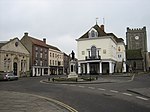Wallingford Bridge
Bridges across the River ThamesBridges completed in 1812Bridges in OxfordshireGrade II* listed bridges in EnglandGrade II* listed buildings in Oxfordshire ... and 4 more
History of BerkshireRoad bridges in EnglandUse British English from March 2018Wallingford, Oxfordshire

Wallingford Bridge is a medieval road bridge over the River Thames in England which connects Wallingford and Crowmarsh Gifford, Oxfordshire (Wallingford was historically in Berkshire until 1974 reorganization). It crosses the Thames on the reach between Cleeve Lock and Benson Lock. The bridge is 900 feet (270 m) long and has 19 arches. It is a scheduled monument. Since the construction of the southern Wallingford bypass in 1993, most traffic crossing the Thames at the town uses Winterbrook Bridge.
Excerpt from the Wikipedia article Wallingford Bridge (License: CC BY-SA 3.0, Authors, Images).Wallingford Bridge
The Street, South Oxfordshire Winterbrook
Geographical coordinates (GPS) Address Nearby Places Show on map
Geographical coordinates (GPS)
| Latitude | Longitude |
|---|---|
| N 51.600694444444 ° | E -1.1204166666667 ° |
Address
The Street
OX10 0BL South Oxfordshire, Winterbrook
England, United Kingdom
Open on Google Maps







